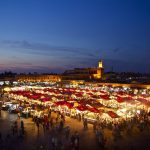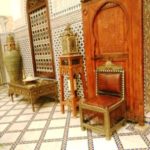As an Amazon Influencer, we earn from qualifying purchases you might make if you click any of the links on this page.
Le Jardin Majorelle in Marrakech, Morocco, is one of those places that fills up your senses on almost every level. From the moment you pass through the walls fill you with Zen like serenity. Like many things in Morocco, the beauty of Le Jardin Majorelle is designed to influence visitors in a positive way.
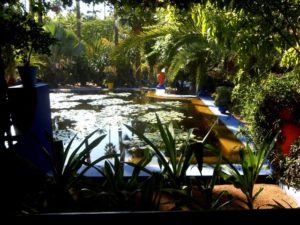
Le Jardin Majorelle is an alluring oasis in the centre of modernising Marrakech within walking or easy horse carriage distance from the frantic shopping mecca of Djemaa El Fna. The garden soothes you and refreshes you instantly as you pass through the entrance. Cool rippling water runs along shallow water courses while towering aged palms humble you with their longevity.
The sculptural shapes of the palms, cacti and succulents strike long light and shadows emphasising their bold outlines. The design is so skillfully done you feel you are looking at a “painted garden”. Landscaping is painting with plants. It uses their textures, light, shade, colours and the extra dimension of plant growth and seasonal changes to create form and shape.
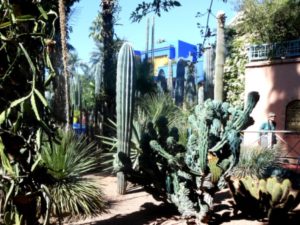
The gardens are lush in a dry succulent way. A massive “Pony Tail” (Beaucarnea recurvata) with several trunks grows from the ground. If you have ever had one as an indoor pot plant, you realise that it must be decades old. Shiny Crassula ovata, commonly known as the money/jade/lucky plant, grows profusely and vigorously. Bold bougainvilleas cascade overhead with clipped shapes encourage profuse flowering – crimson, violet, white. There are Benches at strategic points to encourage guests to pause and bask in the atmosphere.
A Garden in an Artist’s Mind’s Eye
Le Jardin Majorelle has influenced artists and designers since its inception. Their namesake Jacques Majorelle was the successful artist who originally laid out the gardens. Majorelle was also an enthusiastic amateur botanist. He began creating the distinctive garden on land he had purchased in the 1920s. Over time Majorelle became more renowned for his landscaping than his painting.
In the late 1930s the whole garden became a canvas for Majorelle. He began to paint primary colours over the walls and ceramic pots. Majorelle especially loved the brilliantly bold cobalt blue which became his trademark “Marjorelle Blue”. The strong clear light of the African desert suits the strong intense colours that would jar the eye under greyer skies. These intense blocks of colour complement and contrast the multiple shades of the green plants. Subtle trademark terracotta pinks and accented bold yellows contrast the bold Majorelle blue.
Yves Saint Laurent Rediscovered Le Jardin Majorelle
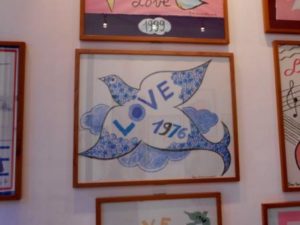
When Marjorelle died in France in 1962 Le Jardin Marjorelle was already in disrepair. By luck Yves St Laurent and his partner Pierre Bergé discovered it on their first visit to Marrakech in 1966. They spent many hours there soaking up the energy and atmosphere. They discovered the dilapidated garden was under threat of being destroyed by hotel property developers but Saint Laurent and Bergé managed to save the garden from bulldozers.
The pair actually bought the garden in 1980 and began to develop it according to Majorelle’s vision. They added many more plants from all over the world so that currently there are 20 gardeners to tend to the needs of the 300 plant species from all over the world.
After Yves Saint Laurent’s death, Bergé scattered his ashes in a quiet corner with an ancient Roman pillar for a monument. He then gifted the gardens to the people of Morocco so that Le Jardin Majorelle can continue to delight and charm guests from all over the world.
The Berber Museum
Majorelle’s old painting studio now houses the Berber Museum. It is the only museum dedicated to Berbers in Morocco, indeed the world. The superb tasteful collections of St Laurent and Bergé form the base of the museum.
The Berbers, also known as Imazighen, are the indigenous people of Morocco. They are found throughout much of Morocco but have a unique language and culture with some influence from Arab, Touareg, and Jewish cultures. The harsh desert environment strongly influences their daily lives, as it has done for centuries. Their unique arts, jewellery and domestic wares reflect these particular tribal customs. Their symbolic Berber alphabet, one of the national languages of Morocco, is especially distinctive .
The Berber museum has three sections.
- The first section has functional household items, old and new. Berber communities still use similar items in daily life.
- The second section houses unique and distinct Berber jewellery. It is expertly made in large weighty silver , out sized beads, with distinctive motifs. If you stepped on any scales wearing one piece, it would certainly add pounds
- The third section displays Berber fabrics. Ancient hand looms are still set up in most tribal homes to weave their carpets and cloaks in such a way that each style and piece tells a story.
At Le Jardin Majorelle there is always time for Shopping and Refreshment
A well stocked bookshop sells art books, prints and mementos at the exit to the museum. A small designer boutique is also beside the museum selling brilliant artisan wares that Moroccans make so beautifully. I fell in love with a divine soft leather shopping bag that cleverly folded flat when not in use so it is on the wish list for my next visit.
Yves Saint Laurent drew annual posters that line one wall. There is also a delightful courtyard nearby to take in the sounds of the resident birds and take time to drink refreshing Moroccan mint tea.
The best time to visit Le Jardin Majorelle is early morning. Then the shadows are still long and the air still cool. It is open every day at 8am. During the time of Ramadan they open at 9 – closing late afternoon.
The Beauty of Le Jardin Majorelle!
It is easy to get to Marrakech these days. It is affordable enough so that you could just drop in for a long weekend from many European countries. Spend a morning wandering for some hours along the cool paths of Le Jardin Majorelle and be refreshed. Leave your iPhone at home. Recharge your soul instead.





